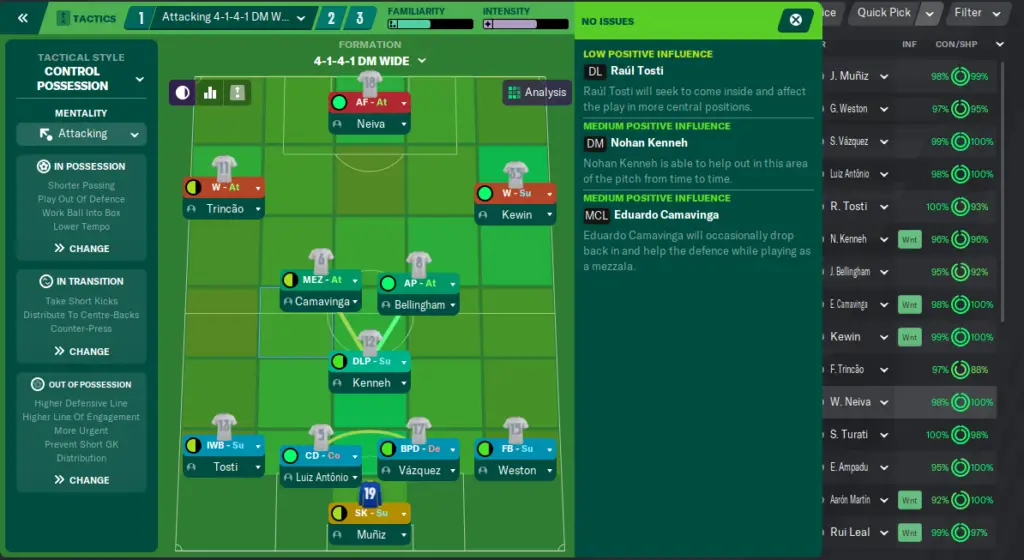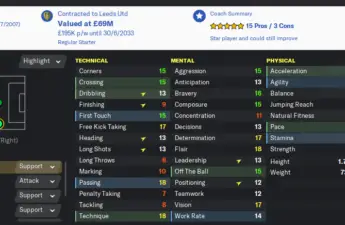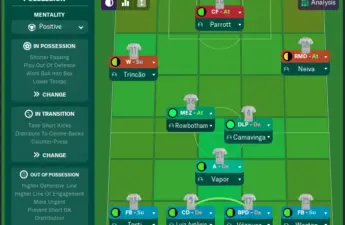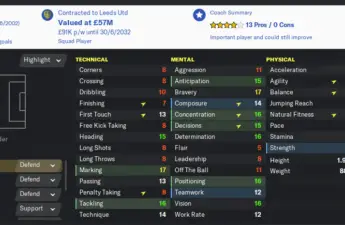Inverted wing backs start in the same position as the more regular wing backs, but rather than running up and down the flanks, they will drift inwards when the team is in possession to create an extra body in the midfield.
Depending on how you want to play, you can have the inverted wing back occupy the space near the defensive midfield or push him higher into the central midfield strata so that he can have more influence in the attack.
Using inverted wing backs in football manager does not mean they will exclusively operate in central midfield areas, as occasionally, they might make normal overlapping runs, depending on their player traits.
Pep Guardiola is notorious for successfully employing wing backs in different variations of his possession based 433 system. Having wing backs, especially Zinchenko, who is originally a midfielder, frees up the two no.8s in Pep’s system to be extremely attacking.
Zinchenko and one of Fernandinho or Rodri would offer defensive cover, while Kevin de Bruyne and David Silva would be freed to move into the attacking midfield positions, creating overloads in the final third.
Different managers have also used inverted wing back systems with varying success, including Julian Nagelsmann at RB Leipzig and Chris Wilder at Sheffield United.
Since the inverted wing back will be spending most of his time in central midfield positions, it is crucial that he is comfortable on the ball and can withstand pressure from the opposition midfield.
This can clearly be seen in players who have mastered playing the position in years gone by, including;
- Philip Lahm at Bayern Munich
- Fabian Delph at Man City
- Oleksandr Zinchenko at Man City
- João Cancelo at Man City
Inverted wing backs will also normally play on the opposite of their stronger foot. This means that if an inverted wing back is right footed, he will best be utilized on the left side of the pitch and vice versa.
This is because they will start in the normal fullback position, but rather than being expected to swing in crosses using their weaker foot, they will use their stronger foot to move inwards with the ball at their feet.
Think of it as how inside forwards and inverted wingers are also normally deployed at the opposite side of their stronger foot so that they can cut into central areas with the ball at their feet of their preferred foot.
Attributes Required for an Inverted Wing Back
First and foremost before thinking about influencing the game in attacking areas, the inverted wing back needs to be defensively solid. Therefore, tackling, marking and positioning need to be at least 14 for a top side in the top five leagues.
Good jumping reach and heading are nice to have, but not necessarily crucial.
Once in possession of the ball, good technique, passing and vision are crucial if the wing back is to make good use of the ball. Aim for these to also be around 14 or higher.
Unlike other fullback roles, you can get away with your inverted wing back having subpar crossing.
Good Player Traits for Inverted Wing Backs
By virtue of occupying central midfield areas when the team is in possession, most player traits suitable for attack minded midfielders will also work well for inverted wing backs.
- Tries long range passes – This could be a useful arsenal if your inverted wing back has a good passing rating. He would be able to pick out your strikers or wingers with pinpoint accuracy from deep positions.
- Plays one-twos – Another useful player trait for players with good passing, playing one-twos increases the tempo of your game and unsettles the opposition, making it difficult for them to pick up runners.
- Tries killer balls often – If you really push your inverted wing back into an attacking role, training him on this PPM could help your team break down packed defences by encouraging risky balls that can split the defence open.
- Switches ball to the other flank – Another player trait suitable for players with good passing, the inverted wing back can utilize this by finding wingers in space who would ideally be hugging the touchline to make the pitch as wide as possible.
Bad Player Traits for Inverted Wing Backs
- Stays back at all times – This player trait will conflict with the inverted wing back tendencies. To make it worse, if you have a tactic where midfielders will push forward, the central areas of the pitch will be left deserted as the inverted wing back will not move into it.
- Plays short simple passes – Now this can be a positive player trait if you want a simple passing game, and your inverted wing back has poor passing. However, in most cases, inverted wing backs are expected to pass more expansively than simple sideways 10 yards passing.
Football Manager Inverted Wing Backs Tactics
One way that Pep Guardiola has successfully utilized wing backs at Manchester City is by having the wingers stay as wide as possible to maintain the width in a 433 system.
You can tweak this by having one inverted wing back and a regular one, then ahead of the inverted wing back have a winger while on the other side use an inside forward or an inverted winger.

In the central midfield areas, three midfielders are ideal, one who will be defensive either as a regista or deep lying playmaker while the other two will be very attacking preferably as mezzalas or one of them as a box to box midfielder if you want to be slightly cautious.
The lone striker should then be assigned a role like the poacher or advanced forward that will leave him to primarily focus on scoring goals rather than bringing his teammates into play.
This system will work well using the control possession instructions or vertical tiki taka from the tactic’s section in football manager.


